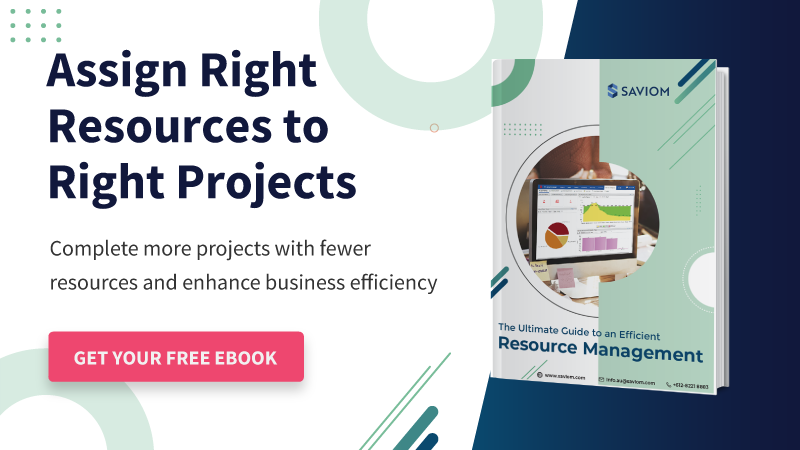Finding it challenging to balance employee workloads?
Struggling to prevent overbooking and conflicts in your resource schedules?
Tired of endless email chains to book resources for projects?
If yes, then you need a robust resource booking strategy to streamline this critical project management function.
Here’s how it works:
Before the project starts, the project manager estimates the type and quantity of resources required to complete the delivery. This resource requisition goes to the concerned resource manager, who identifies and books appropriate resources on the project. After that, it is the project manager’s job to assign various project members to different tasks.
Due to the rapidly changing nature of the project landscape, managers need to alter resource allocation on various activities frequently. It enhances their billable/strategic utilization. It is when the drag-and-drop capability comes in handy while booking resources for tasks.
This article aims to cover the various steps of project resource booking using drag-and-drop functionality. However, before delving deep, let’s get the basics right and begin with the definition and the importance.
What is resource booking?
Resource booking refers to identifying and scheduling various resources for current and future projects for a specific time. Since resources can be either fully or partially available, managers must consider their availability before booking them for various activities.
Some activities, such as juggling members between existing projects or assigning resources to new opportunities before getting rolled off, come under resource booking. It is also necessary for the managers to ensure that the resources are neither overloaded nor underutilized.
Importance of effective resource booking in project management
When resources are efficiently booked, it helps managers to know if the projects are on track for successful project delivery. First, an efficient resource booking process will help managers identify shortages of critical resources and any scheduling conflicts ahead of time. Early recognition of such potential risks will enable the managers to take measures proactively, like training, hiring, adjusting project timelines, etc.
In addition, a well-designed resource booking process helps prevent conflicts and double bookings. It provides a centralized system where individuals can view the availability of resources in real time and make reservations accordingly. This minimizes the chances of overlapping schedules, double bookings and eliminates confusion among teams.
Moreover, when resources are efficiently booked to projects, it ensures that their utilization is on par with their capacity. Furthermore, a resource booking process will enable managers to foresee whether the resources are working on low or high-priority tasks and accordingly mobilize them to billable projects.
Finally, an efficient resource booking process ensures that competent resources are booked for the right tasks, organizations can complete the projects within the stipulated time and budget. This will help eliminate budget and schedule overruns, maintain project quality, and lead to client satisfaction.
Now that you have understood the importance of resource booking in project management let’s look into the drawbacks of using spreadsheets for the same.
Now, let’s explore the various factors that affect the resource booking process.
Factors to consider before booking resources
Ensuring efficient resource booking is vital for smooth project execution and completion. In the following section, we’ll discuss various factors that play a crucial role in achieving this goal. Let’s go through them one by one.
Project requirements
Project requirements play an important role in determining how, when, and which resources are to be booked. Managers must first clearly define the project goals and objectives and create a WBS (work breakdown structure). It allows them to gauge the skill requirements in terms of type, quantity, and competencies for each project phase.
Based on that, managers can identify and schedule competent resources from the internal pool that match these skill specifications. Therefore, determining the project requirement allows managers to align their resource bookings with the project’s goals and ensure successful delivery.
Resource availability
Managers must determine if the organization possesses the requisite resources for a seamless resource booking process. If not, there is a risk of over-allocating or double-booking existing personnel. Further, the situation can turn even more complex if niche-skilled resources are unavailable, given that they are not easily replaceable.
Therefore, managers must ensure resource availability for projects in advance and consider implementing resourcing treatments like out-rotation & backfill or planned hiring. This guarantees that essential resources are at hand to initiate the project on time.
Resource competencies
When booking resources, it is imperative for managers to evaluate resource competencies to ensure seamless project execution. This is because when the right skilled resources are deployed to suitable tasks, they are more productive, less likely to make mistakes, and deliver high-quality outcomes consistently.
However, if an organization doesn’t have the requisite resources, it can either train existing personnel or hire a permanent/contingent workforce to meet the demand. This enables managers to schedule competent resources for projects, ensuring timely project initiation and execution.
Workforce constraints
While booking resources for projects and tasks, managers may encounter several challenges, such as a shortage of niche skilled resources, employee absenteeism, unplanned attrition, etc. Failure to manage these resourcing constraints can lead to project delays and financial losses.
Therefore, creating a well-structured risk mitigation plan to identify and manage these bottlenecks becomes crucial. Managers must forecast project resource demand ahead of time to ensure they have the right people within the organization. Moreover, they must consider employees’ leaves and paid time off before booking them for tasks.
Project and task priority
Managers must carefully consider project and task priority when booking resources, especially in a resource-constrained environment. This approach ensures that scarce, niche-skilled professionals are readily available to work on critical assignments. Furthermore, it prevents the scheduling of over/under-skilled employees to critical tasks, which can result in disengagement, burnout, and sub-par deliverable quality.
Thus, project and task prioritization empowers firms to tackle time-sensitive tasks with approaching deadlines first and optimize the resource booking process. Consequently, it enables managers to efficiently manage profitable projects, prevent unnecessary delays, and ensure on-time delivery.
Now, let’s understand the various setbacks to using spreadsheets to book resources.
Challenges of booking resources using spreadsheets
The market is flooded with a plethora of modern solutions to assign resources to projects efficiently. Yet, many organizations still rely on legacy tools like spreadsheets to book resources on projects. These tools have their limitations and fail to overcome market uncertainties and globalization. Here’s how:
Prone to errors
Spreadsheets are time-consuming and cumbersome. They are also susceptible to human errors during reconciliation, creating erroneous data and a spiraling effect on resource analysis.
According to MarketWatch, “88% of spreadsheets contain some form of errors.”
Creates siloed data
Spreadsheets fail to provide enterprise-wide resource visibility. So, it’s hard to identify and assign the right resources to projects at the right time and cost. Subsequently, delivering projects on time and within budget becomes challenging.
Unable to provide real-time data
Spreadsheets are unable to consolidate data on a single platform. As a result, discrepancies and redundancy can lead to double booking of resources. In addition, without real-time information, decision-makers cannot make timely decisions to improve the organization’s health index.
Difficult to maintain
Though spreadsheets are easy to develop, they are somewhat helpful in meeting initial business requirements only. But as the business expands and changes, spreadsheets fail to meet its current and future needs.
Cannot respond to dynamic market conditions
Spreadsheets lack the functionalities to respond to evolving demands. These tools cannot help determine if a new project can be accommodated within existing constraints, resulting in lost market opportunities.
The solution to these problems is replacing spreadsheets with multi-dimensional resource booking software. Using this tool, one can book resources quickly and effortlessly with an easy drag-and-drop functionality.
Read More: How Outdated Resource Management Tools are Hurting Businesses?
Let’s understand the benefits of drag-and-drop functionality in resource booking.
Advantages of drag-and-drop resource booking
As the name suggests, this feature of resource booking software is a fast and efficient way to plan schedules, meetings, project timelines, and resources. Below are some of the top benefits of drag-and-drop resource booking:
Simple and easy to use
One of the main attractions of drag-and-drop capability in resource booking is its simplicity. One can book resources on tasks or projects in just two clicks, proving to be a real-time-saver for managers. Besides, with no learning curve involved, one can start resource planning and booking resources straight away. The drag-and-drop feature is also instrumental in enabling real-time agile resource booking.
Visually easy to comprehend
Drag and drop capabilities enable you to see changes instantly and provide a quick overview. Due to the visual changes, all relevant parties can see the updates in real-time. It means that everyone is on the same page, and there is no confusion about missed deadlines or scheduled meetings. In addition, it saves you from the hassle of spreadsheet reconciliation and double-booking errors.
Instant alert during resource overload
In matrix organizations with resources working on different projects and having multiple reporting lines, losing track of resource capacity is easy. As a result, double bookings resulting in resource overloading are inevitable. Resource booking system consolidates and tracks resource-related information in real-time. So, when a resource overload is caused by a new booking or editing an existing one, the user gets instantly notified. The user can also view the exact overload hours on the schedule chart and reassign accordingly.
Read More: Significance of Resource Loading in Project Management
Keeps work organized
Unlike spreadsheets, drag-and-drop resource booking software eliminates the endless loop of emails and ensures that any relevant information isn’t lost. While juggling multiple resources and bookings, one can easily zoom in on a particular booking daily or weekly and simultaneously zoom out to track resource engagement over the next quarter, six months, or year. By consolidating all bookings on a single resource plan, managers can easily track project progress, and your team knows what tasks they need to accomplish.
Make changes to bookings effortlessly
Often, when there is a sudden ramp-up activity, finding resources at the right time may not be feasible. Managers can kick-start new projects using resource optimization techniques such as resource leveling or smoothing. The drag-and-drop feature on the resource booking system makes edits effortless and quick. You can also gauge the impact of these changes on other bookings and make modifications accordingly.
Read More: What is Resource Allocation? A Comprehensive Guide for Project Success
Since the benefits of drag-and-drop resource booking are clear, let’s know some of the best ways of resource booking in organizations.
Best practices for resource booking
Implementing some methods can help streamline the resource booking process, improve efficiency, and boost user satisfaction. Below are some of the best practices of project resource booking used across industries. Depending on the situation and requirement, one can apply the ideal one.
Simple booking
This type of booking entails assigning a resource to a single project. One can select the appropriate dimension on the schedule chart and book a specific resource on a project using the drag-and-drop functionality. Depending on the project’s duration, managers can apply suitable timescales like daily, monthly, quarterly, or yearly to book a resource for a specific timeline. One can use a few clicks to define booking details such as project, task, start and end date, effort, role, etc.
Split booking
Overallocation causes employee burnout, compromised work quality, and eventually leads to turnover. Therefore, managers must avoid constantly overloading resources with work. A warning message alerts the concerned manager if a resource gets overloaded with work. They can split their bookings accordingly to optimize and avoid the overallocation. Also, sometimes, resources go on vacations or suddenly leave the organization in the middle of the project. To avoid project delays due to unavailability, managers can split their bookings and reassign them to other available resources.
Read More: Why is the Overallocation of Resources Bad for You?
Bulk booking
In the event of sudden ramp-up activities within a project, an influx of multiple resources is the need of the hour. It can be painstakingly time-consuming if managers have to identify and allocate numerous resources to tasks. Bulk booking can simplify the process by resource scheduling to a project in one go. Using suitable filters, managers can select appropriate resources based on their skills, role, location, and more across the enterprise and book them to a project in just a few clicks. This practice can be a saving grace in the dynamic project management landscape.
Reoccurrence booking
If a booking needs to be repeated later, then a re-occurrence booking is practical. In this case, managers need not create a new booking and simply repeat the booking with just a click of a button. One can also specify the frequency of reoccurrence booking, be it daily/weekly/monthly/yearly, and set the number of times the activity needs to be repeated. This best practice of resource booking saves time and ensures that for a frequently recurring booking, managers don’t end up missing any occurrence.
Generic resource booking
This type of project resource booking system helps fulfill future project demands. Managers can start planning once a project reaches the opportunity or approval sales pipeline stage. Managers can book generic resources first. Once confirmed, managers can reassign these dummy resource bookings to named enterprise resources matching the qualification criteria.
Read More: 4 steps to perfect your Project Pipeline Management strategy
Bulk update
Imagine the following scenarios:
- A single project with multiple resources already assigned to it gets delayed.
- Or, a single resource booked on various projects suddenly goes on leave.
- Due to a sudden high-priority project, the team has to shift their bookings to a later date range.
Editing the bookings individually can be arduous and time-consuming for all these scenarios. In such cases, bulk update, wherein multiple bookings can be revised and updated, is valuable. It simplifies the process significantly, and managers can adjust bulk bookings with just a few clicks.
Bulk copy resource
Sometimes, a new project has a similar structure to a previous one. In such cases, a bulk copy of resource bookings of one project can be duplicated on another project effortlessly without involving the hassles of creating new bookings from scratch. The project manager can directly copy all the bookings of the previous project into the new one in bulk instead of assigning them individually.
Bulk copy by role
This best practice of resource booking is ideal for future and pipeline projects that require similar roles to that of a running project. For such a project, managers can avoid creating individual bookings and generate a bulk copy of resource bookings by role. Once copied, they can simply replace real names with generic ones. Then, when the project probability is confirmed, managers can reassign those dummy bookings to existing resources having the same role and other desired qualifications.
Read More: What is Resource Scheduling? How to Schedule Resources for Projects Efficiently?
These are some of the best practices that can enable effective resource bookings.
Conclusion
To sum up, resource booking software with simple drag and drop has revolutionized how managers conduct project resource planning. Its simplicity and ease of use have made agile resource planning efficient and precise, enabling the successful delivery of projects within time and budget. So, it’s high time businesses still use legacy tools like spreadsheets for project resource booking to invest in modern resource management software. Real-time resource booking systems help organizations enhance profitable utilization and complete more projects with fewer resources.
The Glossary
Read More: Glossary of Resource Workforce Planning, Scheduling and Management
SAVIOM Solution
SAVIOM is the market leader in offering the most powerful and configurable solution for managing your enterprise resources effectively and efficiently. With over 20 years of experience, this Australian-based MNC has created its global presence across 50 countries and helped over 100 customers achieve their business goals. SAVIOM also has products for project portfolio management, professional service automation, and workforce planning software that is customizable as per business requirements.












